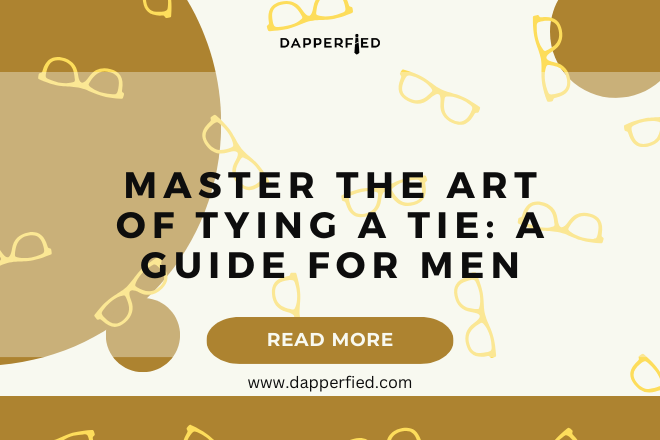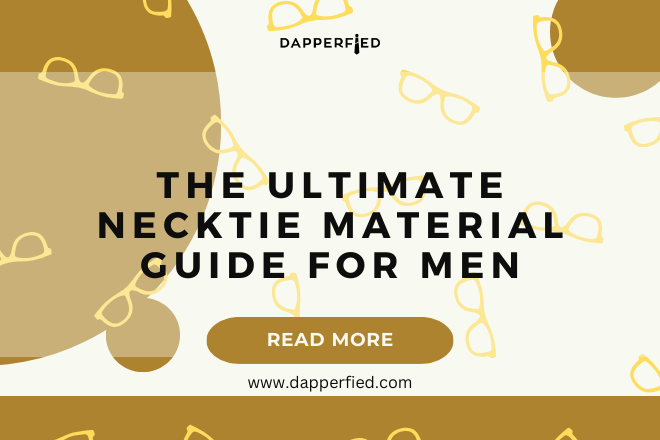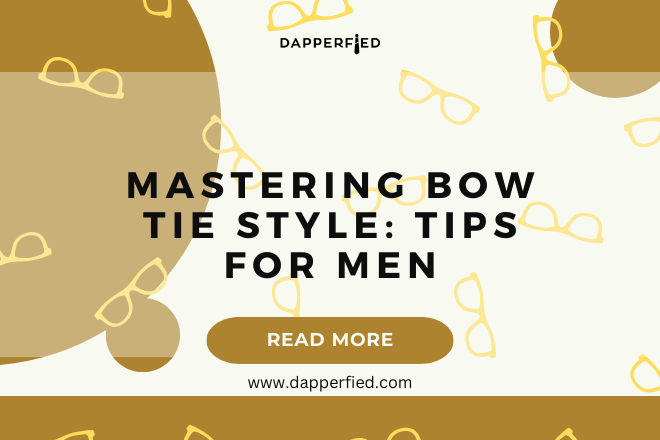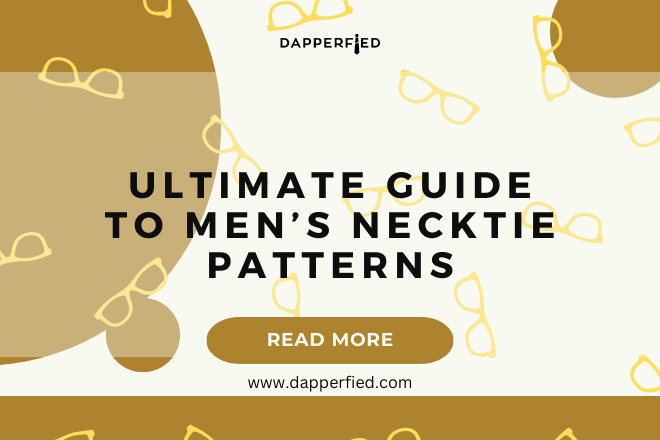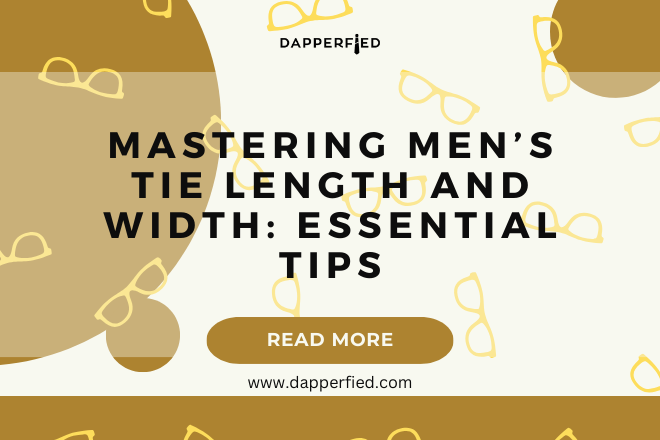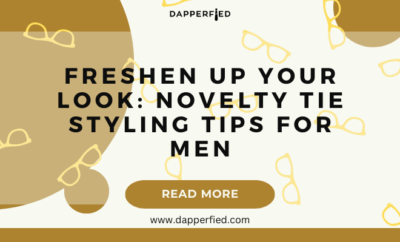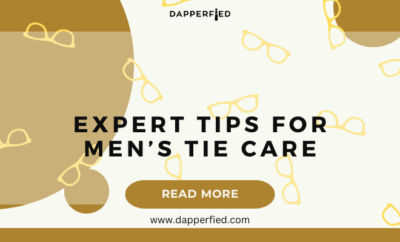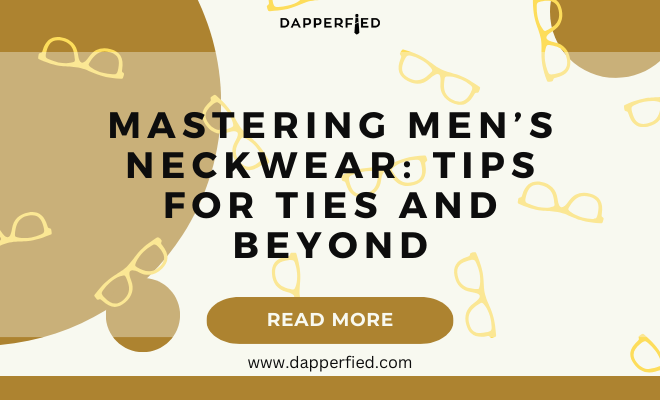
Men's Style
Mastering Men’s Neckwear: Tips for Ties and Beyond
When it comes to choosing the right tie, there are several factors to consider, including patterns, colors, and fabrics. Patterns can range from classic stripes and polka dots to more modern geometric designs and novelty prints. It’s important to consider the occasion and your personal style when selecting a pattern. For formal events, a classic pattern like stripes or a subtle geometric design is a safe choice, while for more casual settings, you can experiment with bolder patterns and colors.
Color is another crucial aspect of tie selection. The color of your tie should complement your shirt and suit, while also adding a pop of visual interest to your outfit. Solid ties in classic colors like navy, burgundy, and forest green are versatile options that can be paired with a variety of shirts and suits. For a more daring look, you can opt for ties in vibrant hues or unexpected color combinations. When it comes to fabrics, silk is the most common choice for ties due to its luxurious sheen and drape. However, other options like wool, cotton, and linen can add texture and depth to your ensemble. Consider the season and formality of the event when choosing the fabric of your tie, as heavier fabrics like wool are more suitable for fall and winter, while lightweight cotton and linen are ideal for spring and summer.
In conclusion, when choosing the right tie, it’s important to consider patterns, colors, and fabrics that complement your personal style and the occasion. Whether you opt for a classic striped silk tie for a formal event or a bold patterned linen tie for a casual outing, the key is to select a tie that enhances your overall look and makes a statement.
Key Takeaways
- When choosing a tie, consider the pattern, color, and fabric to complement your outfit and personal style
- Follow step-by-step instructions for classic and trendy knot styles to achieve a polished look
- Explore other neckwear options such as bow ties, ascots, and cravats for a unique and stylish alternative
- Coordinate and contrast your neckwear with your outfit for a well put-together look
- Properly care for your neckwear by following maintenance and storage tips to ensure longevity and quality
- Understand the historical and contemporary significance of neckwear in men’s fashion
- Personalize your neckwear with customization and accessories to create a unique and individualized look
Tying the Perfect Knot: Step-by-Step Instructions for Classic and Trendy Styles
Tying the perfect knot is an essential skill for any man who wears a tie. While the classic four-in-hand knot is a timeless choice that works well with most collar types, there are several other knot styles to consider, each with its own unique look and level of difficulty. The Windsor knot, also known as the full or double Windsor, is a wide, triangular knot that is well-suited for spread collar shirts and formal events. It requires more steps than the four-in-hand knot but creates a polished and symmetrical appearance.
For a more trendy and casual look, the Pratt knot, also known as the Shelby or Pratt-Shelby knot, is a narrower knot that is ideal for narrow collar shirts and thicker ties. It’s a versatile option that works well with a variety of shirt and tie combinations. The Eldredge knot is a complex and attention-grabbing knot that features an intricate weaving pattern. It’s best reserved for special occasions or fashion-forward ensembles. No matter which knot style you choose, it’s important to practice tying it until you can do so with ease and confidence.
In summary, tying the perfect knot is an essential skill for any man who wears a tie. Whether you opt for a classic four-in-hand knot or experiment with trendy styles like the Pratt or Eldredge knots, mastering the art of tying a tie will elevate your overall look and leave a lasting impression.
Beyond the Tie: Exploring Other Neckwear Options for Men
While the tie is the most traditional form of neckwear for men, there are several other options to consider that can add variety and personality to your wardrobe. The bow tie is a timeless and sophisticated choice that can be worn with formal tuxedos or paired with more casual ensembles for a dapper look. It comes in a variety of styles, including self-tie and pre-tied options, as well as different shapes and sizes to suit your personal preference.
Another alternative to the traditional tie is the ascot, also known as a cravat. This elegant neckwear option features a wide, pleated band that is secured with a decorative pin or clip. It’s a stylish choice for formal events or vintage-inspired looks. For a more relaxed and contemporary vibe, consider the neck scarf or neckerchief. These lightweight accessories can be tied in various ways to add a pop of color or pattern to your outfit while keeping you comfortable in warmer weather.
In conclusion, while the tie is a classic choice for men’s neckwear, there are several other options to consider that can add variety and personality to your wardrobe. Whether you opt for a sophisticated bow tie, an elegant ascot, or a casual neck scarf, exploring different neckwear options can elevate your style and make a statement.
Matching Neckwear to Your Outfit: Tips for Coordination and Contrast
| Neckwear Color | Outfit Color | Coordination | Contrast |
|---|---|---|---|
| Red | Black | Complementary | High |
| Blue | White | Analogous | Low |
| Green | Gray | Monochromatic | Medium |
Matching your neckwear to your outfit involves careful consideration of colors, patterns, and textures to create a cohesive and polished look. When coordinating your tie with your shirt and suit, it’s important to consider both complementary and contrasting elements. For a harmonious look, choose a tie that picks up on one of the colors in your shirt or suit while adding depth with a subtle pattern or texture. This creates a cohesive ensemble without overwhelming the eye.
On the other hand, contrasting your neckwear with your outfit can create visual interest and make a bold statement. Pairing a solid shirt with a patterned tie in complementary or contrasting colors can add dimension to your look while showcasing your personal style. Similarly, mixing different textures like a silk tie with a wool suit or a linen tie with a cotton shirt can create an intriguing visual contrast that sets you apart from the crowd.
In summary, matching your neckwear to your outfit involves careful consideration of colors, patterns, and textures to create a cohesive and polished look. Whether you opt for complementary coordination or bold contrast, the key is to select neckwear that enhances your overall ensemble and reflects your personal style.
Caring for Your Neckwear: Maintenance and Storage Tips for Longevity
Proper care and maintenance are essential for preserving the longevity of your neckwear. To keep your ties looking their best, it’s important to handle them with care and store them properly when not in use. When removing your tie, be gentle and avoid pulling on the fabric to prevent stretching or damage. If your tie becomes wrinkled, use a handheld steamer or hang it in the bathroom while taking a hot shower to release the wrinkles without causing damage.
When storing your ties, avoid hanging them on sharp edges or hooks that can cause snags or tears. Instead, consider using a tie rack or hanger with smooth edges to prevent damage to the fabric. Alternatively, you can roll your ties loosely and store them in a dedicated tie drawer or box to keep them organized and protected from dust and light.
In addition to proper handling and storage, it’s important to clean your ties carefully to maintain their appearance. Spot clean stains with a gentle fabric cleaner or take your ties to a professional dry cleaner for more stubborn stains or thorough cleaning. Avoid using harsh chemicals or machine washing as they can damage delicate fabrics like silk.

In conclusion, caring for your neckwear is essential for preserving its longevity and keeping it looking its best. By handling your ties with care, storing them properly, and cleaning them carefully when needed, you can ensure that your neckwear remains in top condition for years to come.
The Role of Neckwear in Men’s Fashion: Historical and Contemporary Perspectives

Neckwear has played an integral role in men’s fashion throughout history, evolving from functional accessories to symbols of status and style. In ancient civilizations, neckwear served practical purposes such as protecting the neck from harsh weather conditions or signifying social status within the community. As fashion evolved, neckwear became more ornamental and symbolic, with different styles and materials reflecting cultural traditions and societal norms.
In contemporary fashion, neckwear continues to be an important element of men’s style, offering endless opportunities for self-expression and individuality. From classic silk ties in traditional patterns to bold bow ties in vibrant colors, men have a wide range of options to choose from that can elevate their outfits and make a statement. Neckwear has also become an avenue for designers and brands to showcase creativity through innovative designs and collaborations that push the boundaries of traditional menswear.
In summary, neckwear has played an integral role in men’s fashion throughout history, evolving from functional accessories to symbols of status and style. In contemporary fashion, neckwear continues to be an important element of men’s style, offering endless opportunities for self-expression and individuality through diverse styles, materials, and designs.
Personalizing Your Neckwear: Customization and Accessories for a Unique Look
Personalizing your neckwear is an excellent way to showcase your individual style and make a statement. Customization options such as monogramming or embroidery allow you to add a personal touch to your ties or bow ties by incorporating initials, dates, or meaningful symbols. This not only adds a unique element to your neckwear but also creates a sentimental connection that makes it truly one-of-a-kind.
In addition to customization, accessorizing your neckwear with tie bars, clips, pins, or pocket squares can further enhance your look and add personality to your ensemble. These small details can make a big impact by adding visual interest and creating a polished finish to your outfit. Whether you opt for a sleek metal tie bar or a colorful pocket square in coordinating patterns or contrasting hues, accessorizing your neckwear allows you to experiment with different styles and elevate your overall look.
In conclusion, personalizing your neckwear through customization options like monogramming or embroidery, as well as accessorizing with tie bars, clips, pins, or pocket squares, allows you to showcase your individual style and make a statement with your ensemble. These small details can add personality and visual interest while creating a polished finish to your outfit.
If you’re looking for more style tips for men, be sure to check out Dapperfied’s article on “Gentlemen, Be Bold” for some inspiration on how to make a statement with your wardrobe. Whether it’s incorporating bold colors or experimenting with different patterns, this article offers great advice for men looking to elevate their style game. (source)

FAQs
What are the different types of ties for men?
There are several types of ties for men, including the classic necktie, bow tie, knit tie, and skinny tie. Each type of tie offers a different look and can be worn for various occasions.
How should a tie be tied?
A tie should be tied with a simple knot, such as the four-in-hand knot or the Windsor knot. The knot should be tight and symmetrical, and the length of the tie should be adjusted to reach the belt buckle.
What colors and patterns are appropriate for ties?
Neutral colors such as navy, black, and gray are versatile and appropriate for most occasions. Patterns such as stripes, polka dots, and paisley can add visual interest to a tie, but should be paired with a solid-colored shirt for a balanced look.
How should a tie be cared for?
Ties should be hung on a tie rack or rolled up to prevent wrinkles. They should be spot cleaned with a damp cloth if necessary, and dry cleaned only when absolutely necessary to preserve the fabric and shape of the tie.
When should a man wear a tie?
A tie is typically worn for formal or professional occasions, such as weddings, job interviews, business meetings, and formal events. However, the dress code may vary depending on the specific event or workplace.

